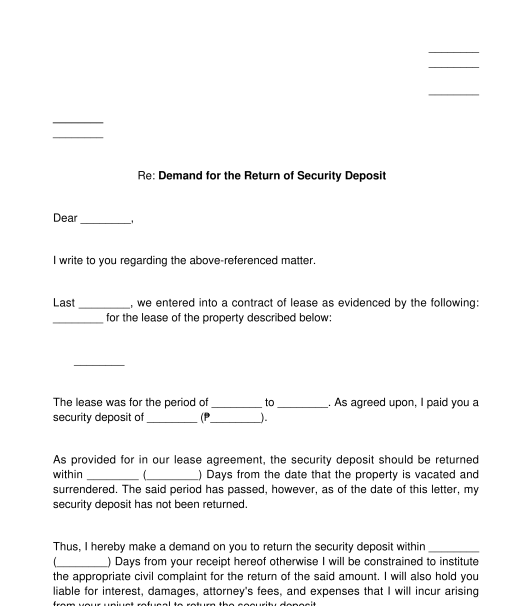 09/06/2025
09/06/2025

Answer a few questions and your document is created automatically.

Your document is ready! You will receive it in Word and PDF formats. You will be able to modify it.

 09/06/2025
09/06/2025
 Word and PDF
Word and PDF
 1 page
1 page
A Demand Letter for Return of Security Deposit is a document that a tenant can use to demand the return of the security deposit. This can be used when the landlord fails to return the security deposit after the tenant moves out of the leased property upon the end of the lease period or, if applicable, within the period agreed upon under the lease agreement.
The security deposit can be used to settle rent, unpaid electric, telephone, water, or such other utility bills or repair any damage to the property caused by the acts or negligence of the Lessee. If at the end of the lease, the rent and utility bills are paid and there is no damage to the property, the security deposit should be returned to the tenant and this document should be used to demand the same.
A demand letter is necessary to put the landlord in default. Being in default means the landlord has failed to pay within the period stated in the demand letter and he shall be liable for the payment of interest, among others. This document can also be used to request the return of the security deposit at an earlier time than that agreed upon.
Note that this document can be used in relation to a Residential Lease Agreement or a Commercial Lease Agreement.
The following are the different types of Demand Letters:
If the tenant wants to bring the issue of non-payment or failure of the landlord to return the security deposit, to a court of law, such court will require that a written Demand Letter be sent to the landlord. Otherwise stated, a Demand Letter is a mandatory pre-requisite before a complaint of a sum of money (i.e. Return of Security Deposit) is initiated in a court of law.
A Demand Letter for Return of Security Deposit contains the following information:
The sender is the tenant who wants to demand the return of the security deposit. And the recipient is the landlord or his authorized representative. The sender must affix his signature thereon to signify that he demands the return of the security deposit.
If it will be sent via registered mail, at least two original copies should be printed. Both original copies of the letter should be signed by the sender (the tenant), one original copy should be kept by the sender and the other should be sent to the recipient (the landlord) by registered mail. After sending, the registry receipt or mail receipt in relation to the mailing of the second original copy must be kept by the sender.
If it will be sent via email, the sender must send an email attaching one scanned copy of the letter that is duly signed by the sender or one digital copy that is electronically signed by the sender. An email is a recommended way of sending this letter as the letter is sent instantly and it will enable the parties to keep their records in a convenient manner.
The lease agreement between the tenant and the landlord may be attached to this letter if there is one.
Costs for sending the Demand Letter may depend on the method used by the sender in sending the letter. Email and instant messaging are the most cost-efficient ways of sending a letter as they are generally free, whereas costs for registered mail or courier will be dependent on the distance between the residence of the sender and the recipient.
Laws on contracts and obligations are generally governed by the Civil Code of the Philippines.
You fill out a form. The document is created before your eyes as you respond to the questions.
At the end, you receive it in Word and PDF formats. You can modify it and reuse it.
A guide to help you: The Security Deposit
Demand Letter for Return of Security Deposit - template
Country: Philippines